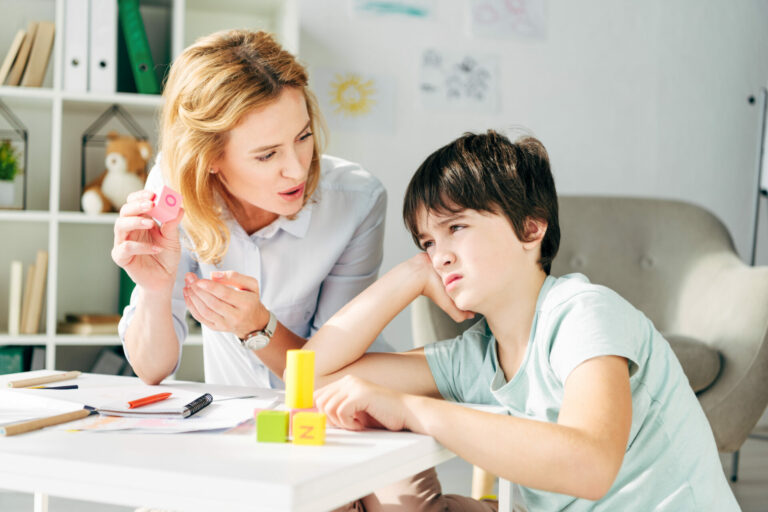Therapy can support adolescents through many walks of life, including stress, mental health disorders, trauma, confidence, school related issues, grief, and more. Adolescence is a difficult and amazing developmental phase. It can also be incredibly confusing. Teens are considered children until they are 18 years old, still learning how to be independent and have a strong sense of self.
At times, it can be difficult for an adolescent to talk to their trusted caregivers or the adults in their lives when going through hard times. Erik Erikson’s stages of psychosocial development teach us that adolescents are going through the stage of Identity vs. Role Confusion. In this stage, adolescents are discovering themselves and developing a sense of self and personal identity. This is accomplished through experience and overall exploration of values and goals (Batra, 2013). A teen’s biggest question during their search for identity is, “Who Am I?”
When an individual is going through this stage in life, they are significantly influenced by social relationships and are getting pulled by things that help them have a sense of belonging. However, since they are developing independence and individuality, at times, adolescence can feel extremely lonely (Soest, Luhmann, & Gerstorf, 2020.)
It is essential to understand that teens are naturally becoming less “attached” to their parents, and more attuned or influenced by their peers. This is all due to them exploring their individualities. Their brains undergo changes, making them highly influenced by social situations (Stangor & Walinga, 2014.)
Therefore, teens might want someone else to talk to. Having a counselor as a third-party individual is one of the many reasons why therapy can be beneficial for a teen. Between the rapid changes in hormones, the social aspects, and schooling, having a safe space to talk through their emotions is an excellent resource. If a teen is going through mental health issues, working through them in therapy can be essential and beneficial to their development into adulthood.
In therapy individuals can learn new skills, meaning that there is an opportunity for one’s brain to rewire itself, resulting in long-lasting positive changes (APA, 2010). For example, if a teen is showing signs of anxiety during class presentations or learning how to drive, a mental health professional can address these issues with them through therapeutic methods that teach them coping skills to use in the future when similar symptoms are appearing.
Ultimately, therapy can be beneficial to teens for so many different reasons!
Lecturas recomendadas
Therapy can support adolescents through many walks of life, including stress, mental health disorders, trauma, confidence, school related issues, grief, and more. Adolescence is a difficult and amazing developmental phase. It can also be incredibly confusing. Teens are considered children until they are 18 years old, still learning how to be independent and have a strong sense of self.
At times, it can be difficult for an adolescent to talk to their trusted caregivers or the adults in their lives when going through hard times. Erik Erikson’s stages of psychosocial development teach us that adolescents are going through the stage of Identity vs. Role Confusion. In this stage, adolescents are discovering themselves and developing a sense of self and personal identity. This is accomplished through experience and overall exploration of values and goals (Batra, 2013). A teen’s biggest question during their search for identity is, “Who Am I?”
When an individual is going through this stage in life, they are significantly influenced by social relationships and are getting pulled by things that help them have a sense of belonging. However, since they are developing independence and individuality, at times, adolescence can feel extremely lonely (Soest, Luhmann, & Gerstorf, 2020.)
It is essential to understand that teens are naturally becoming less “attached” to their parents, and more attuned or influenced by their peers. This is all due to them exploring their individualities. Their brains undergo changes, making them highly influenced by social situations (Stangor & Walinga, 2014.)
Therefore, teens might want someone else to talk to. Having a counselor as a third-party individual is one of the many reasons why therapy can be beneficial for a teen. Between the rapid changes in hormones, the social aspects, and schooling, having a safe space to talk through their emotions is an excellent resource. If a teen is going through mental health issues, working through them in therapy can be essential and beneficial to their development into adulthood.
In therapy individuals can learn new skills, meaning that there is an opportunity for one’s brain to rewire itself, resulting in long-lasting positive changes (APA, 2010). For example, if a teen is showing signs of anxiety during class presentations or learning how to drive, a mental health professional can address these issues with them through therapeutic methods that teach them coping skills to use in the future when similar symptoms are appearing.
Ultimately, therapy can be beneficial to teens for so many different reasons!
Lecturas recomendadas
References
Batra, S. (2013). The psychosocial development of children: implications for education and
society Erik Erikson in context. Contemporary Education Dialogue, 10(2), 249–278.
https://doi.org/10.1177/0973184913485014
Puderbaugh, M. (2023). Neuroplasticity – StatPearls – NCBI bookshelf. National Library of Medicine. https://www.ncbi.nlm.nih.gov/books/NBK557811/
Soest, T., Luhmann, M., & Gerstorf, D. (2020). The development of loneliness through adolescence and young adulthood: Its nature, correlates, and midlife outcomes. Developmental psychology, 56(10), 1919–1934. https://doi.org/10.1037/dev0001102
Stangor, C., Walinga, J. (2014). Introduction to psychology – 1st Canadian edition. https://opentextbc.ca/introductiontopsychology
References
Batra, S. (2013). The psychosocial development of children: implications for education and society Erik Erikson in context. Contemporary Education Dialogue, 10(2), 249–278. https://doi.org/10.1177/0973184913485014
Puderbaugh, M. (2023). Neuroplasticity – StatPearls – NCBI bookshelf. National Library of Medicine. https://www.ncbi.nlm.nih.gov/books/ NBK557811/
Soest, T., Luhmann, M., & Gerstorf, D. (2020). The development of loneliness through adolescence and young adulthood: Its nature, correlates, and midlife outcomes. Developmental psychology, 56(10), 1919–1934. https://doi.org/10.1037/dev0001102
Stangor, C., Walinga, J. (2014). Introduction to psychology – 1st Canadian edition. https://opentextbc.ca/introductionto psychology




